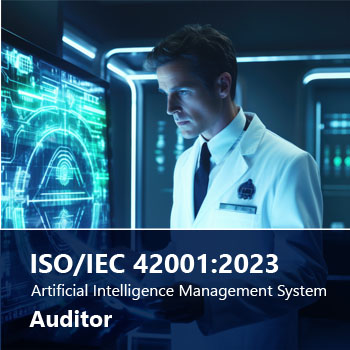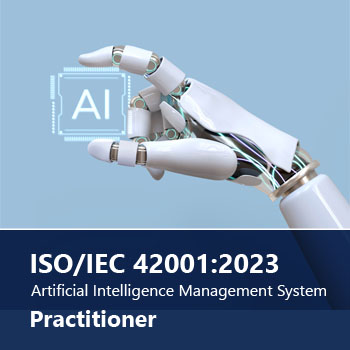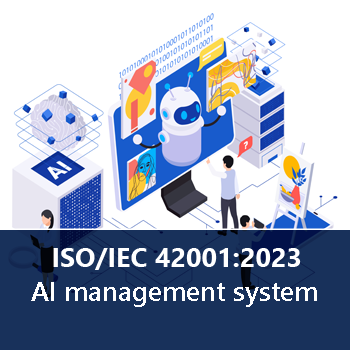ISO/IEC 42001. The ISO standard for AI management - What it is and… what it is not

As artificial intelligence becomes more and more embedded into our daily lives the need for a responsible approach to managing its development, deployment and use becomes a key priority. This is the premise on which the development of ISO/IEC 42001 has been based. This is the first international standard for AI governance, but what exactly is ISO/IEC 42001? And just as importantly, what is it not? Let’s break it down.
What is ISO/IEC 42001?
1. A management system standard
ISO/IEC 42001 is a management system standard, similar in structure to ISO/IEC 27001 (the international standard for information security management). As a management system standard ISO/IEC 42001 provides organizations with a framework for managing AI responsibly, regardless of the organization’s position in the AI ecosystem.
2. Applicable to a vast range of organizations
This standard is designed to be applicable to any organization that develops, deploys or simply uses artificial intelligence. As a result the addressable market for ISO/IEC 42001 is significant. More, this standard can be applied regardless of sector or size of the organization. A tech startup building AI models, a healthcare provider integrating AI into its services, an international financial corporation looking to identify and address fraud or a municipality that wants to improve traffic can use ISO/IEC 42001 as reference.
3. Focused on responsible AI
ISO/IEC 42001 emphasizes fairness, transparency, accountability and the ethical development and use of AI. It helps organizations ensure their AI systems align with legal requirements and societal expectations— avoiding bias, protecting privacy and ensuring security and safety.
4. Aligned with risk-based thinking
Like other ISO management system standards, ISO/IEC 42001 adopts a risk-based approach, requiring organizations to identify and treat risks related to the AI systems they develop, deploy or use. The standard also emphasizes the need for the organization implementing the AI management system to assess the impacts its AI systems may have on individuals, groups of individuals and society.
5. Strong focus on leadership
The support of the organization’s senior leadership is key for the success of the AI management system. ISO/IEC 42001 emphasizes the importance of leadership commitment to responsible AI governance.
6. Compatible with other ISO management system standards
ISO/IEC 42001 has a similar structure to ISO/IEC 27001 which facilitates the integration of these two standards. Organizations already certified to ISO/IEC 27001 can integrate their existing information security management system (ISMS) with the requirements for the AIMS (artificial intelligence management system) from ISO/IEC 42001. Other popular standards, such as ISO 9001, ISO 14001 or ISO 22301 may also be integrated with this new standard for AI management.
7. Can be used for the certification of organizations and persons
ISO/IEC 42001 can be used for audit and certification purposes. An organization can implement an AI management system according to ISO/IEC 42001, be audited and certified for compliance with this standard. The certification process is similar to that for other popular standards such as ISO 9001 or ISO/IEC 27001. Individuals can also obtain a certification as practitioners or auditors for artificial intelligence management systems according to ISO/IEC 42001.
What ISO/IEC 42001 is not
1. This is not a technical standard for AI models
ISO/IEC 42001 does not define how to build an AI model, write code, or train a neural network. This standard is not about technical specs or algorithms — it’s about governance and accountability at organizational level.
2. It is not limited to high-risk AI systems
ISO/IEC 42001 is not a standard to be applied only by organizations developing or using AI systems that come with significant risks for users and other stakeholders. The principle is that the organization must manage risks and opportunities following a well-defined process considering also the impacts of its AI systems on individuals, groups and society. The threshold for risk acceptance is to be defined by the organization and the selection of risk treatments will consider the organization’s resources and its risk appetite
3. ISO/IEC 42001 cannot be used to certify an product
ISO/IEC 42001 is a certifiable standard for organizations, not for AI systems. You can’t get your chatbot or vision system “certified” — but your organization’s AI management practices can be audited and certified.
4. This standard is not a substitute for regulation
The standard complements, but does not replace, laws and regulations like the EU AI Act. It can help organizations meet regulatory expectations, but compliance with ISO/IEC 42001, like with any management system standard, is voluntary. Holding a certification to ISO/IEC 42001 is not a substitute for compliance to the relevant laws and regulations.
5. ISO/IEC 42001 is not a one-size-fits-all checklist
The application of the AI management system should be adapted to the specifics of the organization in question, its sector, size, legal obligations, stakeholder expectations or its role in the AI ecosystem. The implementation of ISO/IEC 420001 will vary in terms of applicable controls and details. It will likely be more challenging to implement an AI management system for the companies developing AI systems, those for those who just use AI for various purposes.
So, ISO/IEC 42001 is not exactly a one-size-fits-all documentation and its use should be carefully tailored to the organization and its context.
Final Thoughts
ISO/IEC 42001 is an interesting and important document, step forward in building trust and accountability in AI. While most efforts these days seem to be focused on technical aspects and AI efficiency, this standard provides a framework for developing, deploying and using AI responsibly, in line with legal requirements and societal expectations.
As AI becomes more pervasive, so too will the scrutiny. Implementing ISO/IEC 42001 can help organizations demonstrate their commitment to responsible AI and build long-term trust with customers, regulators and the public.
Whether you're in early-stage AI adoption or already scaling complex systems, ISO/IEC 42001 offers a powerful tool to govern AI responsibly and transparently.
For a detailed presentation of the requirements in ISO/IEC 42001 you can take our online curse available here
If you are intersted in becoming certified as AIMS professional, then you should check our certification programs for AIMS practitioners and AIMS auditors.


